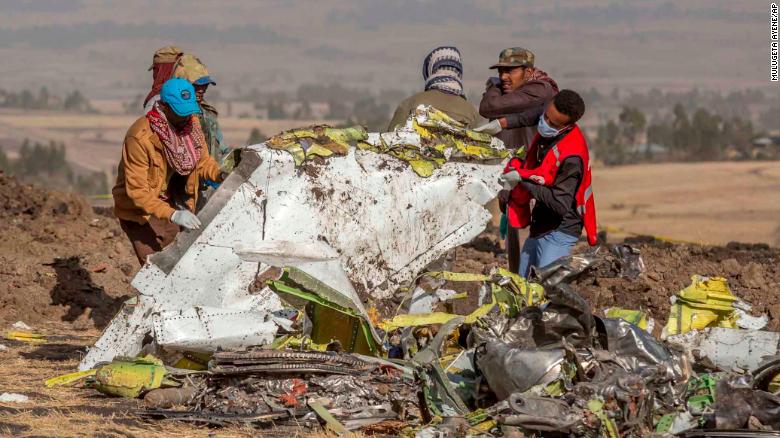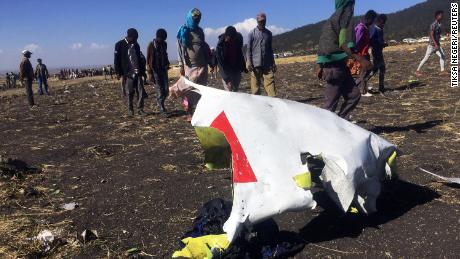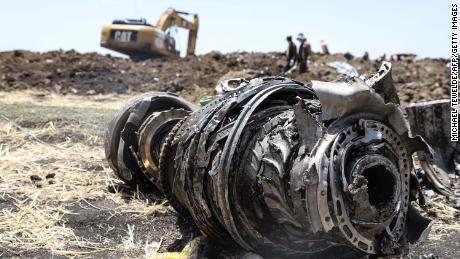(CNN)When the Federal Aviation Administration announced it was grounding all Boeing 737 Max planes, the agency said it had identified similarities between last month's Ethiopian Airlines crash and the Lion Air crash in Indonesia six months earlier.
The Ethiopian Minister of Transport reiterated that point on March 17, saying preliminary data recovered from the black boxes of the crash in Ethiopia showed similarities to the Air Lion crash.
Neither agency provided many specifics.
So how were the two crashes similar?
This is what happened with each flight
Ethiopian Airlines Flight 302 crashed the morning of March 10 after taking off from Addis Ababa on its way to Nairobi, Kenya, killing all 157 people on board. The plane was carrying passengers from around the world, many of whom worked for the United Nations.
Lion Air Flight 610 crashed into the Java Sea in Indonesia on October 29 after taking off from Jakarta. All 189 people on board died. The plane was scheduled to make a one-hour journey to Pangkal Pinang on the island of Bangka.
Both were Boeing 737 Max 8 planes
The Boeing 737 Max 8 was a new model unveiled to great fanfare by the US aviation giant about two years ago. The airline also produced a Max 9 and has plans to offer a Max 7 and Max 10, with model numbers based on seating capacity.
There are approximately 350 Boeing 737 Max 8 aircraft in operation worldwide, belonging to 54 operators, according to the FAA.
Boeing's website says the 737 Max is the fastest-selling plane in the company's history, with about 5,000 orders from more than 100 customers worldwide.
President Donald Trump said on March 13 his administration was ordering the grounding of all Max 8 and 9 models, hours after Canada said it was grounding the planes after analyzing new satellite tracking data.
Both planes used the same software
The planes were equipped with automated flight software called the Maneuvering Characteristics Augmentation System (MCAS), a relatively new feature to Boeing's Max planes.
The MCAS is a system that automatically lowers the nose of the plane when it receives information from its external angle of attack (AOA) sensors that the aircraft is flying too slowly or steeply, and at risk of stalling.
The AOA sensors send information to the plane's computers about the angle of the plane's nose relative to the airflow over and under the wings to help determine whether the plane is about to stall.
A preliminary report into the Ethiopian Airlines crash obtained by CNN does not specifically name the plane's MCAS, which is suspected to have contributed to the Lion Air disaster. But its findings make it likely that the system pushed the plane into a dive fueled by erroneous angle of attack sensor readings.
Jean-Paul Troadec, the former head of France's aviation accident investigation bureau, told CNN that he saw flaws in the system.
"I think the design of this system is not satisfactory as it relies on only one sensor," he said. "In case this sensor fails, of course the system doesn't work. And in this case it could be difficult for the pilot to overreact to the system."
Boeing CEO Dennis Muilenburg said a software update and related pilot training for the 737 MAX will be released "soon" and will address concerns discovered in the aftermath of the Lion Air crash.
Both planes crashed shortly after takeoff
The Ethiopian Airlines flight went down six minutes after takeoff.
The Air Lion plane crashed 13 minutes after taking off.
Both planes had experienced crews
Ethiopian Airlines tweeted that the first officer had 350 hours of flying time and the pilot in command had 8,100 hours.
The captain of the Lion Air flight, Bhavye Suneja, an Indian national, had more than 6,000 flight hours, and his copilot, named Harvino, had logged more than 5,000, according to a statement posted by Lion Air.
The International Civil Aviation Organization, an agency of the United Nations, recommends commercial pilots have a minimum of 150 hours. The FAA requires that commercial pilots have 1,500 hours.
Both pilots reported problems
The Ethiopian Airlines pilot said he was having difficulties and asked to return to base, Ethiopian Airlines CEO Tewolde GebreMariam told CNN. The pilot was granted permission to return to ground around the same time the flight disappeared from radar.
The pilots on board Ethiopian Airlines flight battled the plane's automated systems for nearly the entire duration of the 6-minute flight, according to the preliminary report into the crash obtained by CNN.
Unable to stabilize the 737 Max 8 plane, even after following the emergency procedures recommended by Boeing, the pilots tried together to pull the jet's nose up repeatedly during the last moments of the flight, the preliminary report revealed. But the downward force of the aircraft was too great to overcome.
The captain called out "pull up" three times to tell the second-in-command to raise the nose. Both pilots tried to pull the nose up together to keep the plane flying, but they were unable to regain control.
The preliminary report, which has not yet been publicly released, does not come to a finding of probable cause. A final report could take as long as a year to produce. ŌĆŗŌĆŗ
Seventy seconds after takeoff from Addis Ababa's Bole International Airport on March 10, one of the angle of attack sensors on board the aircraft began providing faulty information to the aircraft's systems, indicating an imminent stall to the flight crew.
The stick shaker on the pilot's yoke -- another system intended to warn a pilot of an imminent stall -- began shaking the yoke. Incorrectly sensing a stall, the aircraft's system tried to force the nose down four separate times during the flight, in the end overpowering the flight crew's ability to keep the airplane climbing.
Recognizing a problem with the automatic trim, the pilots followed emergency procedures and turned off the system. Instead, the pilots tried to use the backup manual trim wheel to adjust the trim, but the airplane was traveling too fast and the manual trim wheel would have been physically impossible to operate.
Less than two minutes later, the plane crashed.
A preliminary report by Indonesia's National Transportation Safety Committee said the crew of Lion Air Flight 610 struggled to override the plane's automatic systems in the minutes before it plunged into the ocean. The system pulled the plane's nose down more than two dozen times, the report said.
The report said the MCAS system was responding to incorrect data transmitted by an AOA sensor. A different flight crew experienced the same issue on a flight from Denpasar to Jakarta the previous day, but had turned off the MCAS and took manual control of the plane, the report said.























